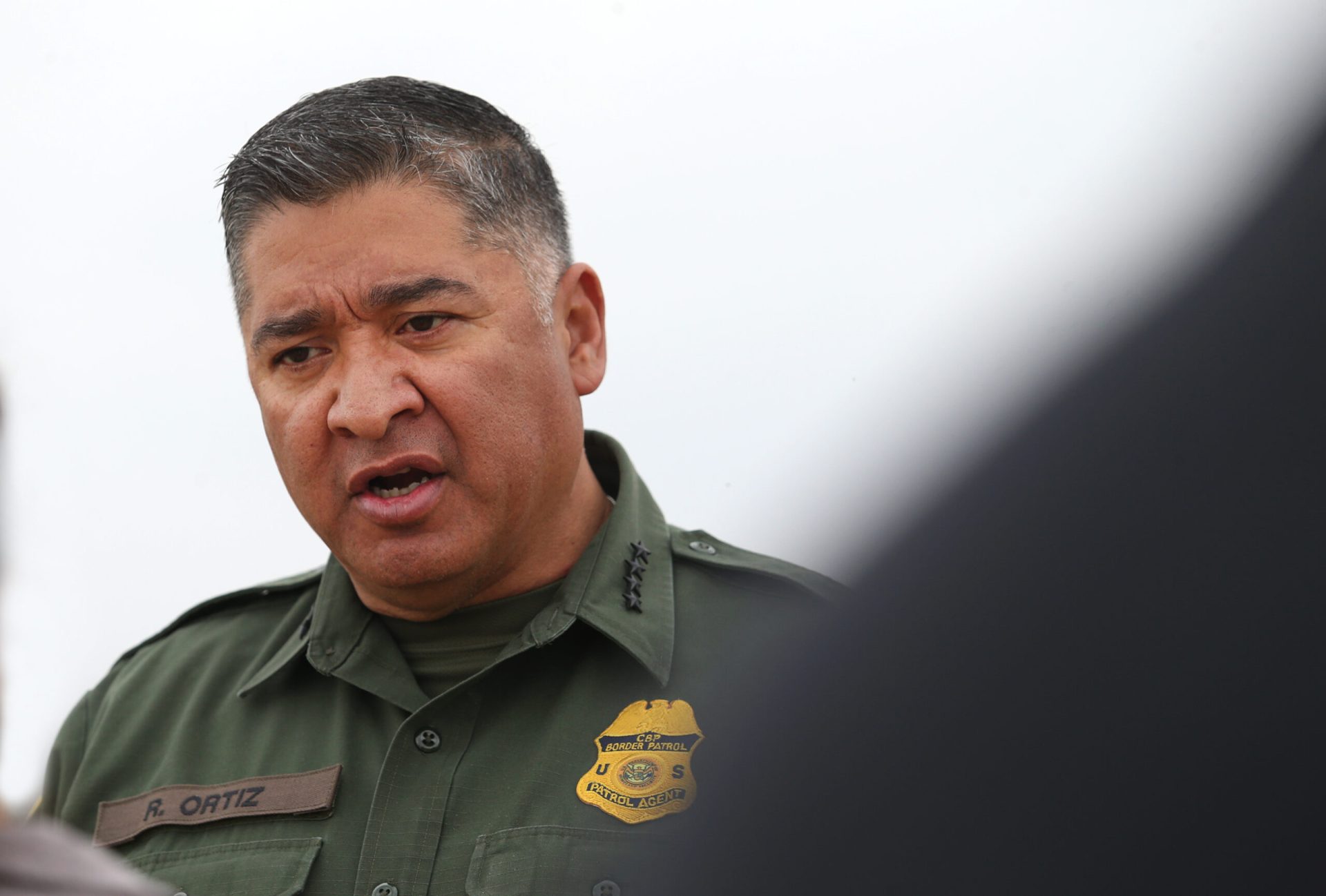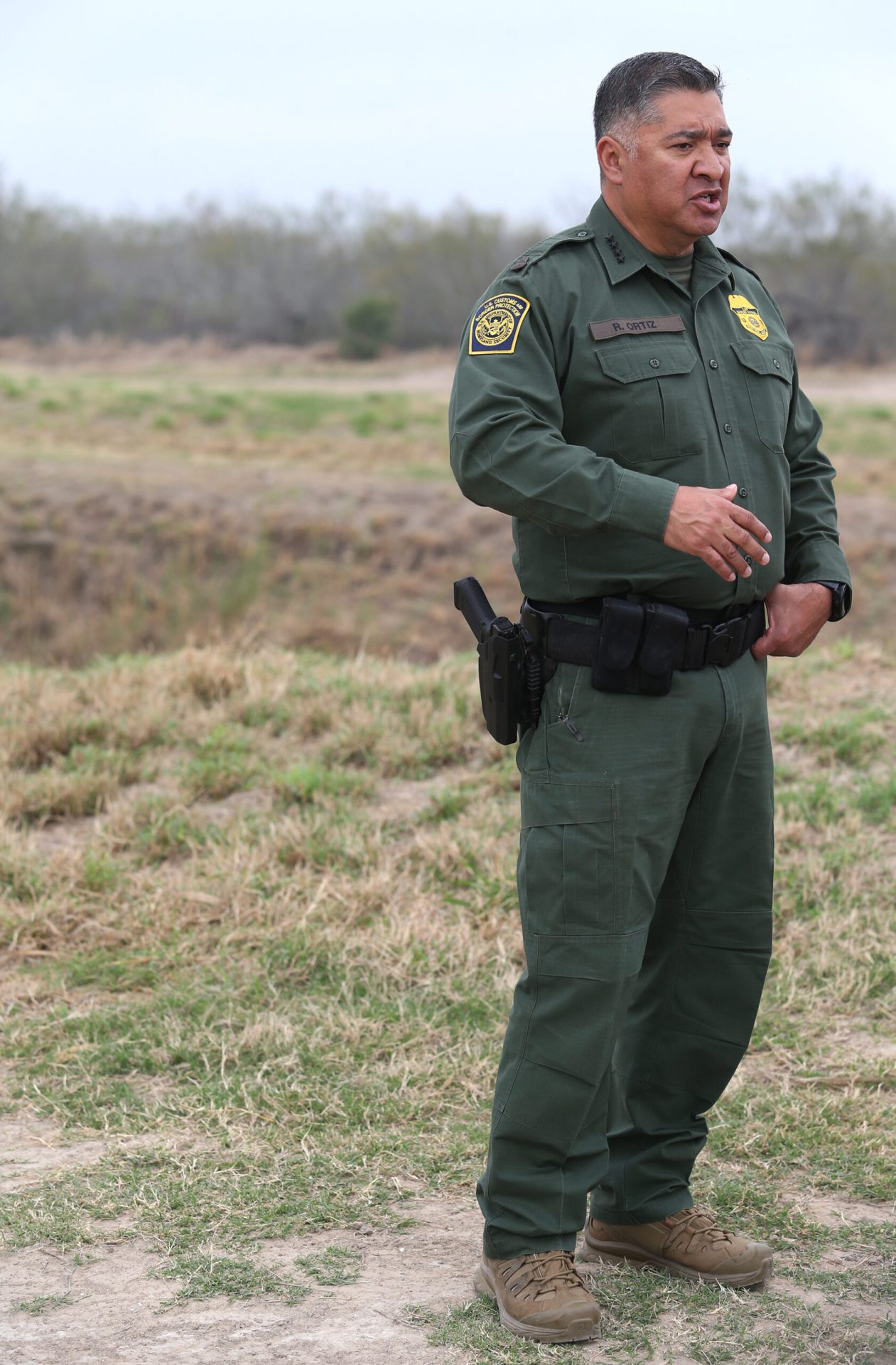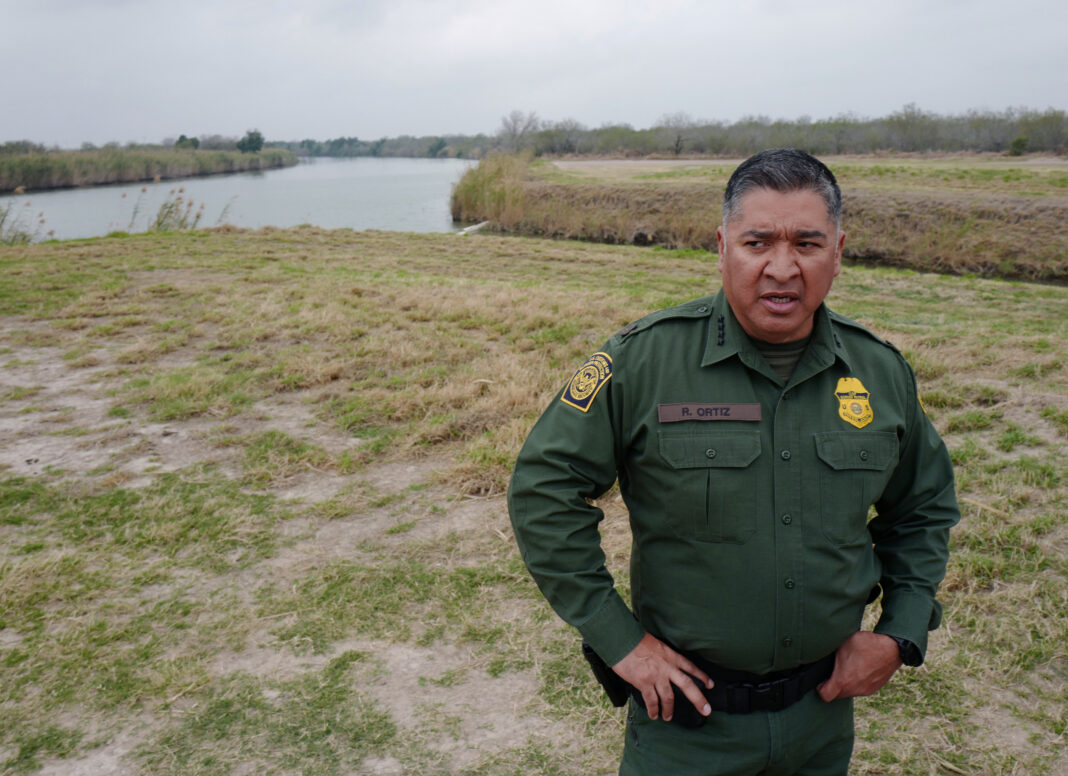A month after facing “unprofessional” challenges by Border Patrol subordinates in a video leaked to media, Chief Raul Ortiz embarked on a border tour to engage agents on concerns raised as the agency braces for a greater test to their operations.
Standing near a canal connecting with the Rio Grande in Peñitas behind a section of border wall, Ortiz, dressed in rough-duty uniform, as opposed to the dress uniform fitting his high rank, contemplated on the last few weeks.
“When the Secretary and I came out we heard, very candidly, from our workforce about some of the issues,” Ortiz said, recalling the visit to Arizona and Texas he made with DHS Secretary Alejandro Mayorkas. “And, I also thought that there needed to be a follow up discussion and with a smaller group.”
Mayorkas and Ortiz were battered with questions and criticism from field agents in Yuma and Laredo in late January.
“I really appreciated the openness with which the agents expressed their views. A couple guys might have expressed them, what I thought was unprofessionally, which was surprising to me because it’s something I’ve never seen in the Border Patrol in my, what is it now, eight years of exposure, person-to-person exposure,” Secretary Mayorkas later said during a sit-down recorded conversation. “The substance of what was communicated really called for action and we’re jumping on it.”
During a visit to Laredo on Jan. 28, a four-minute video was recorded catching a conversation midway into the topic of Border Patrol suicides, which Ortiz said Wednesday had been increasing recently.
“I agree with you. I do think that morale is at an all-time low. I do think that we’re losing way too many agents,” Ortiz told agents that day as Secretary Mayorkas stood by. “One of my friend’s is getting buried in Tucson… a retired chief who committed suicide this past week. He has two sons in the Border Patrol, still. And, that’s tough.”
Ortiz continued and said CBP’s chief operating officer, who focuses on resiliency, will help create programs and initiatives to provide care for their physical, mental, and even spiritual well-being.
Halfway into the response, agents interrupted.
“You can’t even say illegal alien,” one agent said off-camera.
“For evil to triumph is for good men to do nothing. That’s exactly what’s happening here. Good men are doing nothing. You’re allowing illegal aliens to be dropped off in communities,” an agent said, quoting a refrain and referring to the release of immigrants once they’ve been processed by the Department of Homeland Security.
Visibly upset facing defiant employees, Ortiz responded during a heated conversation that lasted about two minutes.
“You’re getting bogged down in the policies and the politics,” he said.
Overlapping criticisms and responses broke down after an agent asked about a different topic, but the conversation had since lingered on the chief’s mind.
Agents have yet to face discipline for the manner in which they expressed their discontent, though Ortiz said the discussion continued past Jan. 28.
“I actually had conversations with several of those agents, personally, phone call conversations, and every single one of them said, ‘Hey, chief, we never meant any disrespect. We just wanted to make sure that we shared with you,’” Ortiz added.
Looking back at the incident, the chief said he wouldn’t change his approach.
“But, no. I’m going to continue handling it the same way, because I think that one, they need to hear the passion from me about how I feel about this issue and the things that I’m doing to help improve the conditions here on the ground,” Ortiz said, reflecting on the conversation.

A calm river flowed past a large clearing next to Las Palomas Wildlife and under overcast skies Wednesday. Ortiz had just been there a few hours before during a night shift with horse patrol agents prior to meeting with the media that morning. This tour of the southern border was preceded by visits to the Big Bend, Del Rio and Laredo sectors.
“Rio Grande Valley continues being ground zero for us,” Ortiz remarked.
Apprehensions in the Valley remain highest compared to all sectors. So far, about 26% of all immigrants encountered by Border Patrol this year happened in the area.
Migration flows shifted last year, however; and now Yuma and Del Rio claim 15% and 19% of the total encounters. Two years ago, they didn’t even break into the double digits claiming only 9% and 5% of apprehensions, respectively, during the same time period.
Border Patrol is now making long-term plans to compensate for the lack of permanent infrastructure in those areas.
“What I don’t want to do is process these individuals in tents, which I’m doing quite a bit across the entire southwest border,” Ortiz said. “We recognize that migration is going to continue, and we have to start planning for this being an enduring issue and be able to prepare for it accordingly.”
The agency is preparing to increase their holding capacity in the three sectors with the highest levels of apprehensions.
“We are looking at setting up joint processing centers in a couple of locations. We think that Del Rio probably would be optimal, and then Yuma, Arizona,” the chief stated.
In a few days, the Valley sector will begin using the renovated Central Processing Center, also known as Ursula because of the street it’s located. It will have an approximate capacity to hold 1,200 people. Though, Ortiz said they won’t be closing down the temporary processing center they created in Donna with a capacity of 1,625, or a COVID-adjusted capacity of 813.
“We’re going to keep Donna,” Ortiz affirmed.
That center operated at 446% of its COVID-adjusted capacity, or 223% of its normal capacity during a peak in apprehensions on Aug. 1, 2021.
The numbers slowed down since, but they remain historically high. Though the agency is expecting a considerable change in the near future.
“Once Title 42 goes away, agents are going to be, you know, that’s going to compound their processing duties and responsibilities,” the chief said, referring to a policy that is leveraged to expel thousands of asylum seekers during the pandemic.

The policy has allowed the U.S. to turn back nearly half of all people who attempted to enter into the country so far this year and about 60% of those apprehended in 2021. However, the practice was intended to be temporary to help stop the spread of disease during a pandemic.
The CDC just eased mask usage restrictions on Friday, the latest indication of a positive trend during the global health crisis but a precursor to the end of Title 42.
“So, we’re working on a couple of things. I’m trying to get 1,000 more processing coordinators through our academy and out here into the field as quickly as I can,” he said, hoping it would free more agents from processing duties and allow them to work on enforcement duties along the border.
The effect of mass apprehensions on daily assignments was observed last year when at the height of apprehensions, Border Patrol leadership in the Valley considered leaving some of the busiest checkpoints in South Texas unmanned to move agents to processing duties.
“I’m trying to get contractors into our processing centers so agents can get back here and do their patrol duties and be less focused on these processing responsibilities that they have right now,” Ortiz said.
He is also working on getting about 2,000 more border agents, creating contingency plans with the other agencies like ICE and ORR which help move migrant adults, families and children from Border Patrol facilities, and coordinating with the Mexican government.
“I’ve asked for more technology. I asked that they close the gates and the gaps, to give me appropriate funding to do that. I’ve asked them to allow us to create enforcement zones, so the agents can patrol laterally,” the chief said.
In spite of the apparent improvements, new strings of COVID-19 threaten against the agency’s plans.
“It was a month ago when I had 1,400-1,500 people in a quarantine status. Those are 1,400-1,500 agents who aren’t out here operating in a 24-hour period, and then that goes on for five days” Ortiz explained. “Numbers are much lower, probably 150 today which isn’t so bad. But, it can spike at any moment. So, that is a concern of mine.”
As Ortiz and the federal administration prepare for what may come ahead for the U.S., they are keeping global vigilance to anticipate changes prompted in other countries.
“But, I will tell you, when you think about the global strife, I expect that our numbers are going to increase,” he said.
Editor’s note: This story was updated to include remarks from Secretary Mayorkas.




